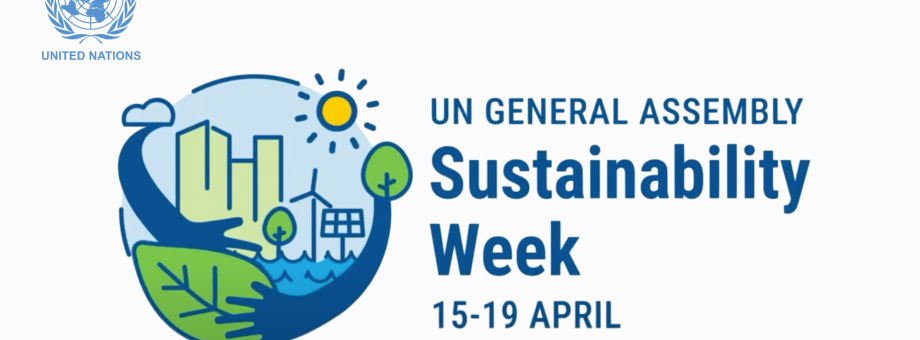SUMMARY of the UN General Assembly High-level Meeting on Sustainable Transport (17 April 2024) sets up recommendations for the Implementation Plan (Atlas of Transport Sustainability) of the UN Sustainable Transport Decade 2025-2035

United Nations General Assembly
High-level Meeting on Sustainable Transport
Wednesday, 17 April 2024 General Assembly Hall, UN Headquarters
SUMMARY
On 17 April 2024, the President of the General Assembly at its seventy-eighth session, H.E. Mr. Dennis Francis, convened the High-Level Meeting on Sustainable Transport as part of the Sustainability Week, at the United Nations Headquarters in New York. The event aimed to highlight sustainable and effective solutions to improve the balance between economic, social, and environmental dimensions of sustainable transport, and to take full advantage of sustainable transport in accelerating the implementation of the 2030 Agenda for Sustainable Development.
Opening segment
The President of the General Assembly, H.E. Dennis Francis, highlighted the significant role of transport sector in global output and economic growth, and recalled that over 1 billion people still lack access to all-weather roads, making ensuring equal access the foremost priority for the international community on sustainable transport. He also stressed the particular challenges faced by countries in special situations: Landlocked Developing Countries, Small Island Developing States, and Least Developed Countries as well as vulnerable communities. He highlighted that the upcoming UN Decade of Sustainable Transport, starting in 2026, presents a unique opportunity to recalibrate the global approach towards the transformative power of sustainable transport. He stressed that sustainable transport is not merely an option but a catalyst to drive progress across multiple fronts of sustainable development, calling for innovation-driven approaches to promote multimodal and intermodal transport system, and to confront the negative impacts and consequences of transport.
Under-Secretary-General, Mr. Li Junhua reported that the transport sector is responsible for a quarter of the global greenhouse gases emissions and has a low share of renewable energy use. Mr. Li called for increasing efficiency of transport system, reducing fossil fuel use, and further investments in public transport. He stressed that each milestone should be celebrated, highlighted that the shipping industry, as one sector that of a 20 percent increase in greenhouse gas emissions over the last decade, is taking steps in the right direction. He noted that the UN Department of Economic and Social Affairs has been tasked to develop the implementation plan for the UN Decade of Sustainable Transport, in collaboration with the UN regional commissions, and in consultation with the Member States, the wider UN system, and relevant stakeholders. He noted that the High-Level Meeting on Sustainable Transport provided a great opportunity to gain further insight into the current and emerging priorities for the global community on sustainable transport.
Mr. Batyr Annaev, Minister and Chairman of the Türkmendeňizderýaýollary Agency, Cabinet of Ministers of Turkmenistan, on behalf of H.E. Serdar Berdimuhamedow, President of Turkmenistan, underscored the importance of transport at the global level and mentioned the General Assembly’s
recent designation of 26 November as the World Sustainable Transport Day. He highlighted Turkmenistan’s national transport strategy approaches, including a program for transport diplomacy to identify areas for further capacity building, as well as international cooperation in enhancing transport systems.
Multi-stakeholder panel
There was a report on transport initiatives by the UN Regional Commissions: the launch of the Africa Integrated High-speed Railway Network project, by the African Union, with the support of the Economic Commission for Africa; the introduction of the Integrated Transport System by The Economic and Social Commission for Western Asia, by the Economic and Social Commission for Western Asia; the establishment of a regional cooperation mechanism on low carbon transport, by the Economic and Social Commission for Asia and the Pacific; the efforts to integrate various transport projects to improve urban life, by the Economic Commission for Latin America and the Caribbean; and the work of the Economic Commission for Europe on road safety and regulatory functions.
Public transport was presented as one of the key solutions to the challenges posed by climate change, urban sprawl, congestion, and economic and social marginalization. Ambitious political leadership, prioritization of efficient transport, stable and long-term funding, and effective governance were highlighted. Countries were suggested to consider ambitious transport mode shift targets when updating their Nationally Determined Contributions for climate by 2025.
It was underlined that intermodal mobility networks and supply chains need to be robust and resilient to crises, such as natural disasters and conflicts. It is critical to eliminate legislative obstacles, to create a regulatory environment with real business incentives, and to offer creative carbon free transport solutions, in order to provide resilient and socially inclusive transport services. Three specific suggestions were provided: first, global coordination on transport should be accompanied by appropriate stakeholder engagement; second, performance indicators must be established to help monitor progress; and third, encourage partnerships with the road transport industry to implement real changes.
Ten key transformations were identified to support transport delivery on equity, sustainability, and climate goals: (1) maximizing accessibility and minimizing environmental impact; (2) promoting compact cities and sustainable infrastructure; (3) connecting rural and urban communities; (4) prioritizing public transport and active mobility; (5) shaping transport behavior; (6) electrifying transport modes and integrating them with local renewable energy production; (7) reflecting “true costs” and green investments; (8) promoting efficient freight transport systems; (9) promoting coherent industry, trade, and transport policies towards circular economies; and (10) investing in resilient infrastructure. There was a suggestion that the UN Decade of Sustainable Transport should include a shared vision for the required transformation by mid-century that is centered on people and planet, and the implementation plan should identify targets of global reach for local impact, particularly for low- and middle-income countries, and lever more and better investment in transport systems.
Member States are also urged to join the UN Group of Friends of Sustainable Transport. Two concrete measures for the upcoming UN Decade of Sustainable Transport were highlighted: first, to
develop a specific questionnaire to be distributed among representatives of the global business community and leading sectoral organizations, in order to better understand priorities, expectations, and possible downfalls in future activities; and second, the promoting mutual recognition of authorized economic operators to reduce costs and transit time along multimodal transport corridors without compromising security and customs consideration.
Plenary segment
During the plenary segment, as well as interactive dialogue of the multi-stakeholder panel, representatives of the Member States and Observers, as well as the UN System and other stakeholders delivered statements and made interventions. There was a broad recognition of the importance of sustainable transport in achieving economic growth, social development, and environmental sustainability. A summary of the main messages is as follows:
· The importance of the UN Decade of Sustainable Transport was highlighted. This initiative holds immense significance in advancing sustainable transport, creating new opportunities, and fostering sustainable development on a global scale. Sustainable transport should address people’s needs to access opportunities, services, and goods, while advancing economic and social development, with minimal environmental impact.
· There is a need to dramatically improve access to multimodal and intermodal transfer systems, making transport a solution for the equity, sustainability, and climate challenges that we are facing. While new technological solutions, resilient infrastructure and renewable fuels are needed.
· Due to their geographical and infrastructure deficiencies, LLDCs face unique development challenges, including high transport costs that discourage investors and undermine LLDCs’ competitiveness, limiting their capacity to achieve sustainable development. Reliance on neighboring countries to access international markets makes LLDCs more vulnerable to cross- border restrictions and supply chain disruptions.
· There is a need to ensure that landlocked developing countries can become truly “land-linked” through effective transit corridors. Several actions in support of the LLDCs were mentioned, including upgrading transport connectivity with neighboring countries, utilizing existing UN multilateral conventions, such as the TIR Convention, and ensuring international support for leveraging additional infrastructure financing.
· In general, better utilization of existing solutions, such as UN Conventions, digitalized transport services, eliminating regulatory and procedural barriers to transport and trade was highlighted.
· Speakers highlighted the need to ensure that all transport modes: inland, maritime and aviation, contribute to making transport more sustainable. Regarding aviation, the Single African Air Transport Market, launched in 2018, was specifically cited as a project of the African Union 2063 Agenda to create a single unified air transport market in Africa to advance the liberalization of aviation in the continent impetus to the economic integration agenda.
· Over the last decade only 6 to 7 per cent of passenger journeys were made by rail, even though rail transport holds great potential for reducing greenhouse gas emissions and increasing accessibility and safety of transport. Proposals were made to ensure a modal shift towards
public transport, active transport modes such as walking and cycling, and rail. Actions that increase access to rail transport system globally could include setting specific targets within the NDCs, providing policy and fiscal incentives, and increasing investments in order to increase both passenger and freight rail transport.
· Establishing a sustainable and interconnected transport network is critical for enabling trade, economic growth, and social development. Climate change is contributing to increased fragilities in developing countries across the world, particularly many SIDS face additional challenges due to their geography and vulnerability. While some of these challenges can be addressed at the local level, others necessitate global support and action for increasing resilience of transport infrastructure and networks.
· Numerous speakers highlighted the need to prioritize safety in transport policies. The Global Plan for the Decade of Action for Road Safety 2021-2030 and the road safety related targets in the 2030 Agenda should be fully implemented. Education and driver training were mentioned as some of the key, affordable measures for enhancing road safety.
· Most participants reiterated the importance of increased political will and international cooperation, in order to leverage technology transfer and capacity building, financing, private sector expertise, and innovation to support the development of sustainable transport opportunities.
Annex
President of the General Assembly
Suggestions to the implementation plan for the UN Decade of Sustainable Transport
The following substantive and action-oriented points contributing to the implementation plan for the UN Decade of Sustainable Transport were discussed:
· To include a shared vision for the transformation of transport system by mid-century that is centered on people and planet.
· To ensure equal access to sustainable transportation for the most vulnerable people.
· To enhance capacity building, particularly for low- and middle-income countries.
· To highlight the special challenges and needs of LDCs, LLDCs, and SIDS, and maximize synergy with relevant Programs of Action.
· To build resilience on transport infrastructure.
· To promote more public, private and innovative investment in transport and mobility systems.
· To involve the private sector and leading sectoral organizations, in order to better understand priorities, expectations, and possible downfalls in future activities.
· To leverage the power of science and technology, and to accelerate modal shifts and green transition in transport sector.
· To further strengthen international cooperation, including develop international and regional transport and transit corridors, share best practices on implementing national transport strategies and programs.
· To identify targets of local impact by global reach.
· To fully reflected road safety targets related to 2030 Agenda for Sustainable Development.
· To establish indicators to monitor the progress during the Decade.
****


 STATEMENTS
STATEMENTS